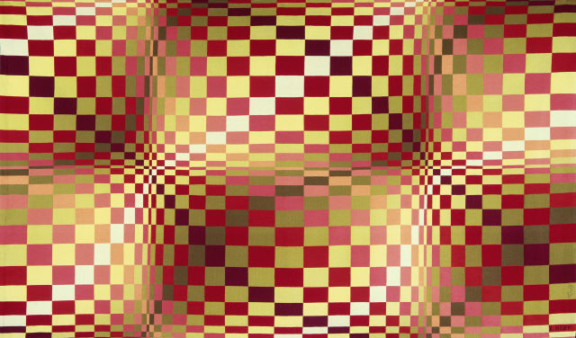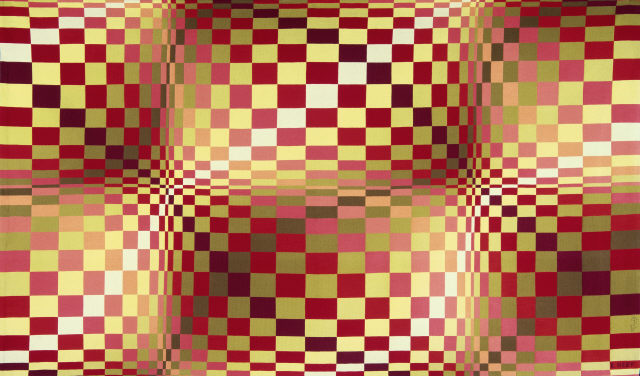
- 1969
- Wool
- Handmade weave
- Inv. TP13
Eduardo Nery
Espaço Ilusório
This large-scale tapestry work, created after a previously made card according to traditional techniques, applies to the decorative field the images which Eduardo Nery developed throughout a long and rich series of gouaches and paintings. It is this historic series of works that established the artist’s reputation as the most significant proponent of op art (together with Artur Rosa) in Portugal.
However, Nery’s work possesses multiple facets, both stylistic and technical. The artist has continued to carry out, sometimes simultaneously, or in cycles to which he repeatedly returns throughout the decades, experiments in the fields of expressionist abstraction and op art, photography and intervention in urban decoration, a style of painting which he called metaphysical, and a long series of collages created as a form of critical intervention. In chronological terms, in tandem with the growth of the international movement during the 1960s, whose informal “headquarters” were at Denise Renée’s Gallery in Paris, Nery’s visual experiments would, in a pioneering manner, enrich the chromatic rhythms and the spatial illusionism that characterised op art through an intensely rich range of shades. Some of the characteristics found in this tapestry (Illusory Space) that are common to other op art experiments include the sensation of infinitude inherent in the mesh constructed by the image (which seems to extend itself beyond the traditional boundaries of the pictorial image), the sensation that the volumetric, undulating surface of a work that is naturally two-dimensional is moving or breathing, and the absorption of the gaze and body of the observer looking through the screen of the image. In this tapestry, however, these characteristics are magnified by the realisation, in the real dimensions of the tapestry, of the monumental scale implicit in the original card.
The broadening of the notion of the observer of an artwork is essential to this stage or dimension of Nery’s work, which, whether in tapestry, public painting (including the Franjinhas building, created by the architect Nuno Teotónio Pereira in Lisbon, an intervention currently destroyed), countless tiled panels (Avenida Infante Santo, Lisbon), or designs for urban paving, has made a decisive contribution to the redesigning of cities and the visual culture of their inhabitants.
João Pinharanda
May 2010
| Type | Value | Unit | Section |
| Height | 176 | cm | |
| Width | 292 | cm |
| Type | Acquisition |
| 50 Anos de Arte Portuguesa |
| Lisboa, Fundação Calouste Gulbenkian, 2007 |
| ISBN:978-972-678-043-4 |
| Catálogo de exposição |
| Arte Portuguesa 1992 |
| Colónia, Alemanhã, Vista Point Verlag, 1992 |
| ISBN:3 88973 602 5 |
| Catálogo de exposição |
| Exposição Retrospectiva de Eduardo Nery |
| Museu da Água |
| Curator: Museu da Água |
| 4 de Março de 2004 a 18 de Maio de 2004 Museu Nacional Soares dos Reis |
| 30 de Outubro de 2003 a 29 de Novembro de 2003 Sala de Exposições Temporárias da Estação Elevatória a Vapor dos Barbadinhos |
| A exposição esteva patente no Museu da Água antes de ir para o Museu Nacional Soares dos Reis. |
| Exposição Inaugural do Museu da Tapeçaria de Portalegre |
| Câmara Municipal de Portalegre |
| Curator: Câmara Municipal de Portalegre |
| 4 de Julho de 2001 a 31 de Janeiro de 2002 Museu da Tapeçaria de Portalegre |
| Exposição no âmbito da inauguração do Museu da Tapeçaria de Portalegre, espaço especificamente dedicado à apresentação, conservação e estudo, de uma parcela fundamental do património artístico nacional que a Tapeçaria de Portalegre representa. |
